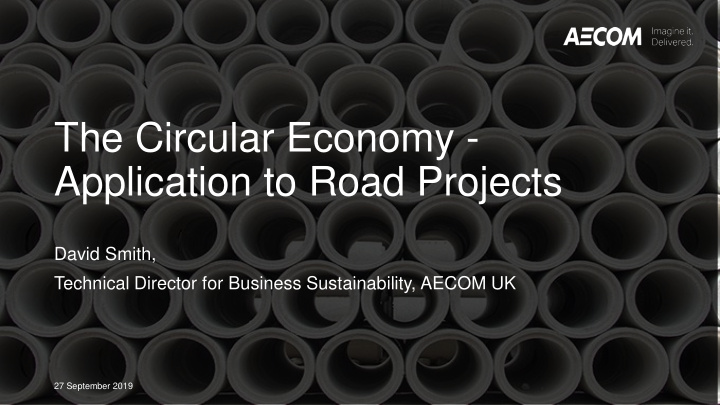



The Circular Economy - Application to Road Projects David Smith, Technical Director for Business Sustainability, AECOM UK 27 September 2019
The Circular Economy “A circular economy is one that is restorative by design, and which aims to keep products, components and materials at their highest utility and value, at all times.” Ellen MacArthur Foundation, 2013
Introducing the Circular Economy Resource Management – Working Towards a Circular Economy From IEMA, Environmental Management Briefing: Driving Sustainable Resource Management through IS0 14001 (2017)
The Circular Economy
Highways England – Moving towards the circular economy
Highways England - Key drivers for the circular economy – Competition for resources – Material criticality Studies: • Heightened supply chain risk; • Vulnerability to supply restriction; and • Environmental implications – The need to ensure security of supply – The need to work within resource constraints – Potential safety and financial benefits – Climate change / requirement to development low carbon infrastructure.
Highways England – Key benefits of the circular economy – Improved delivery and service to customers: • Reduced resource consumption, procurement, purchase, processing and waste management costs; • More sustainable performance; with • Improved management of business risk. – Secure supply of materials at a reasonable and stable price • Management of environmental, ethical and social impacts that could otherwise damage Highway’s England’s reputation. – Creation of opportunities for new business • New business models, products and services for its supply chain.
Highways England - Corporate Commitment – Highways England’s license to operate (2015) includes a requirement to put sustainable development into practice. – ‘Manufactured Capital - circular economy’ is one of the five key elements of Highways England’s Sustainable Development Strategy (2017).
Development of a Circular Economy Route Map
Highways England’s approach to the circular economy 1. Minimising demand for primary resources and maximising the reuse of resources already in use on the network. Reutilising resources in as high a value applications as is possible. 2. Being innovative; working with suppliers to find new ways to deliver a more resilient and adaptable network – seeking efficiency and value for money.
Highways England’s approach to the circular economy 3. Working to achieve security of supply; working with others to improve the stability and predictability of demand for high performance products and services. Enabling suppliers to invest in innovative approaches and secure long-term partnerships with wider supply networks, their staff and wider communities; 4. Supporting the objectives of Biodiversity 2020, seeking to reverse biodiversity loss and, in the longer term, delivering biodiversity gains; and 5. Adoption of a natural capital approach to capture the value of the off road land holding.
Pathfinder Projects
The A14 Circular Economy Pathfinder Project Re- • Opportunities to generate and use renewable energy and materials generate • Opportunities to restore the heath of ecosystems • Prolonging the life of assets through consideration of durable design, opportunities for maintenance upgrades &retention of high material value through end of life reuse Share • Opportunities to work with other major infrastructure schemes to facilitate sharing of plant and reuse of resources such as excavated and secondary materials (e.g. MI-ROG) • Working with local skills agencies to help develop local capability & capacity. • Designing out waste and recording materials data via BIM to support future asset management Optimise • Improving resource management such as reducing waste through off-site manufacture and development of programme level resource management planning tools. • Seek to achieve longer term resource reuse with maintenance of material value? Loop • Improving resource management such as reducing waste through off-site manufacture and development of programme level resource management planning tools. • Looking for opportunities to ‘ demateralise ’ services, for example, removing the need for overhead Virtualise gantries by transmitting information to in- car ‘set - top boxes’ Share • Adoption of BIM will provide accurate, GIS linked knowledge of infrastructure composition and location, with the potential to reduce the demand for investigative excavations. BIM will improve Exchange resource management and maintenance across the road network.
The A14 Circular Economy Pathfinder Project
Circular Economy Pathfinder Projects
Identification of opportunities Design plays a critical role in the shift to a circular economy by influencing Pre-project the way we make, consume and dispose of products. Options Influence Development Construction Project Delivery
Stonehenge – Amesbury to Berwick Down scheme
Stonehenge – Amesbury to Berwick Down scheme
Stonehenge – Amesbury to Berwick Down scheme
Recommend
More recommend